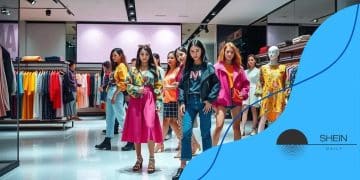Shein’s role in the online fashion economy: a game changer

Shein’s role in the online fashion economy is pivotal as it rapidly sets trends and influences consumer behavior through affordable pricing, extensive social media marketing, and a commitment to fast fashion.
Shein’s role in the online fashion economy has sparked conversations about the changing tides of shopping culture. Have you noticed how quickly trends come and go these days? In this article, we delve into Shein’s influence on fashion dynamics and what it means for consumers and brands alike.
Understanding Shein’s business model
Understanding Shein’s business model is crucial to grasp how it has rapidly become a dominant player in online fashion. This company employs a unique strategy that sets it apart from traditional retailers.
Fast Fashion Approach
At its core, Shein is a fast-fashion brand. It focuses on producing trendy styles at a breakneck pace. By quickly responding to fashion trends, it captures consumer interest almost immediately.
Direct-to-Consumer Model
Shein operates under a direct-to-consumer model, cutting out middlemen. This ensures lower prices for consumers and higher profit margins for the brand. By connecting directly with customers through its website and app, Shein streamlines the shopping experience.
Data-Driven Design
Another key aspect of Shein’s business model is its reliance on data. The brand analyzes online shopping patterns and social media trends to tailor its offerings. This strategy helps Shein launch new collections frequently, keeping its inventory fresh and appealing.
- Utilizes social media influencers for marketing.
- Offers a wide array of styles catering to diverse tastes.
- Engages users with promotional events and flash sales.
Furthermore, their pricing strategy is aggressive. By offering large discounts and promotions, Shein attracts a young demographic that values affordability. This pricing strategy, combined with efficient logistics and distribution, enhances customer loyalty.
Understanding Shein’s business model reveals the company’s ambition to dominate the online fashion market. Its innovative use of technology and keen marketing strategies position it as a leader in the fast-fashion space.
The impact of fast fashion on consumer behavior
The impact of fast fashion on consumer behavior is profound. As brands like Shein rapidly produce new styles, shoppers find themselves constantly craving the latest trends. This cycle encourages a shift in how individuals perceive clothing and shopping.
Impulse Buying
Fast fashion encourages impulse buying. Shoppers often feel pressure to purchase items quickly, fearing they might sell out. This urgency creates a sense of excitement, but it can also lead to buyer’s remorse when consumers realize they don’t truly need the items.
Changing Wardrobe Dynamics
With affordable options available, many consumers adopt a more disposable attitude toward clothing. Instead of investing in quality pieces, they buy numerous less expensive items. This behavior can lead to overcrowded wardrobes and the need for more frequent cleanouts.
- This trend promotes a throwaway culture.
- People often replace garments rather than repair them.
- Environmental awareness is growing as more consumers recognize waste issues.
Social media plays a critical role in this dynamic. Influencers showcase new outfits regularly, influencing followers to buy similar items. This trend also brings attention to the idea that having diverse outfits is more important than owning high-quality pieces.
Furthermore, the constant stream of new arrivals makes consumers feel they need to keep up, fostering a cycle where they purchase more to fit in with current styles. As a result, fast fashion has altered consumer behavior, making shopping a dynamic and often frantic experience.
Sustainability challenges in the fashion industry

Sustainability challenges in the fashion industry are becoming increasingly critical as environmental concerns rise. Fast fashion brands like Shein face scrutiny for their impact on the planet.
Environmental Impact
The production of clothing often results in significant waste and pollution. Fabrics like polyester release microplastics into oceans, harming marine life. Furthermore, many dyes and chemicals used can contaminate local water sources.
Resource Depletion
Fashion contributes to resource depletion through excessive water use, especially in cotton production. It can take thousands of liters of water to create a single T-shirt. This raises concerns about water scarcity in affected regions.
- Sustainable practices are often cost-prohibitive.
- Recycling and upcycling initiatives are gaining traction.
- Consumers are becoming increasingly eco-conscious.
Moreover, labor conditions in factories pose ethical challenges. Many workers are paid low wages and work in unsafe environments. This raises questions about the true cost of cheap clothing for consumers and the responsibility brands hold.
As consumers demand more transparency, brands are pressured to adopt sustainable practices. This includes using eco-friendly materials, reducing waste, and ensuring ethical labor practices. However, transitioning to sustainability can be slow and costly, creating challenges for many businesses.
How Shein influences global fashion trends
How Shein influences global fashion trends is a fascinating topic in today’s fashion landscape. This brand not only reflects current styles but also shapes them, impacting consumers worldwide.
Rapid Trend Production
Shein excels at identifying and producing fashion trends quickly. By leveraging data and analytics, they can track what styles are gaining popularity on social media. This allows Shein to create new collections that align with the latest trends, often within a matter of days.
Social Media and Influencer Marketing
The brand heavily utilizes social media platforms. Influencers promote Shein outfits, reaching millions of followers. This creates immediate visibility for new styles and encourages followers to adopt similar looks.
- Utilizes TikTok for viral fashion challenges.
- Collaborates with influencers to showcase trendy outfits.
- Engages in targeted ads based on user preferences.
Furthermore, Shein’s ability to adapt to consumer feedback enables it to stay ahead in the fashion game. Real-time data collection allows the brand to understand what customers want, making adjustments to their inventory accordingly.
Additionally, their pricing strategy makes fashion accessible to a wider audience. With affordable prices, Shein attracts younger demographics who are eager to experiment with their style.
By offering a continuous flow of fresh styles, Shein promotes a culture where looking fashionable is an everyday pursuit. This has led to a global phenomenon where trends can emerge and disappear rapidly, driven by the demand for the next big thing.
The future of online fashion with Shein
The future of online fashion with Shein is an exciting topic as the brand continues to innovate and adapt to consumer needs. As technology advances, Shein is likely to lean into digital strategies that enhance the shopping experience.
Increased Use of Technology
Shein is already using data analytics to understand fashion trends quickly. In the future, we can expect them to implement even more sophisticated AI tools to predict customer preferences. This could lead to highly personalized shopping experiences, suggesting outfits based on previous purchases or browsing habits.
Virtual Shopping Experiences
The concept of virtual reality (VR) shopping is emerging in the fashion industry. Shein may develop VR showrooms where customers can try on clothes virtually. This innovative approach could change how consumers shop online and increase conversion rates.
- AI-driven chatbots may assist customers 24/7.
- Augmented reality (AR) features could allow users to see how clothing fits before buying.
- Enhanced mobile apps could streamline the shopping process.
Moreover, sustainability considerations will play a significant role in Shein’s future. As consumers become more eco-conscious, the brand might invest in sustainable materials and ethical production practices. This shift can help foster brand loyalty among environmentally aware shoppers.
Shein’s ability to respond to market changes and consumer demands will be vital for its continued success. Keeping prices affordable while improving quality and sustainability will put the brand in a strong position as competition grows.
FAQ – Frequently Asked Questions about Shein’s Impact on Online Fashion
What makes Shein a leader in online fashion?
Shein quickly adapts to trends and utilizes social media influences to reach a broad audience, making fashion accessible.
How does Shein influence consumer behavior?
Shein encourages impulse buying and a fast fashion mindset, leading consumers to seek out the latest trends often.
What sustainability challenges does Shein face?
Shein deals with issues like resource depletion and ethical production practices, which are critical for its long-term success.
What technology is shaping the future of Shein?
Shein may incorporate AI and virtual reality to enhance the online shopping experience and meet consumer demands.





